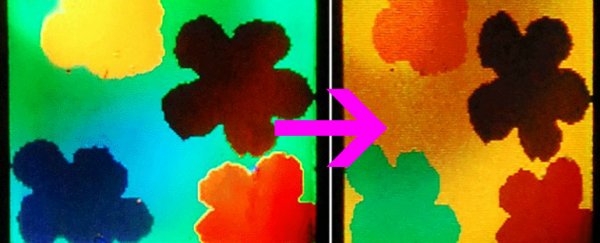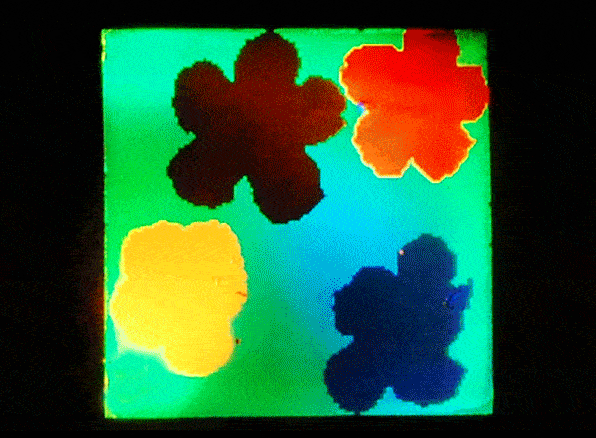Researchers have created a thin, flexible material that changes colour when it's stretched or bent even a tiny amount, and it has some pretty exciting potential for the future of camouflage.
The 'artificial' skin was inspired by chameleons, and doesn't involve any dyes or pigments. Instead, the material has thousands of tiny features etched into its surface, which physically changes the way light is reflected depending on how it's bent. This results in an incredible colour-shifting ability as you can see below.
Created by engineers from the University of California, Berkeley in the US, the material's most obvious application is in creating adaptable camouflages that can change to suit different backgrounds. But it could also be used to create vivid new displays, such as billboards that change colour, and detect when an object is shifting, for example if a building is beginning to sag even a tiny amount - which is definitely something we should know about.
The material works by creating structural colour, rather than chemical colour, which is how things such as fabric, leaves and paint get their colour. When light strikes the surface of these objects, certain wavelengths of light are observed by their unique chemical composition, leaving only select wavelengths to be reflected back to our eyes. When shorter wavelengths are reflected back we see things as having a blue hue, and when longer wavelengths are reflected back we see a red hue. And if you want to change the colour of an object, you'll need to change its chemical make-up.
Structural colour, on the other hand, is controlled by tiny scales or features on the surface of an object, which interact to reflect particular waves of light depending on their spacing. This is how butterflies create the intense colours on their wings, what makes eyes blue, and how chameleons control their skin tone.
To create the new material, the researchers mimicked this approach by etching tiny ridges, smaller than the wavelength of light, onto a silicon film just 120 nanometres thick - one thousand times thinner than a human hair. Depending on how the spaces of these ridges are "tuned", the researchers were able to control which wavelengths of light were reflected by the material. And once they'd worked that out, they realised that they could ben and stretch the material even the smallest amount, and they'd be able to change the colours it was reflecting.
"If you have a surface with very precise structures, spaced so they can interact with a specific wavelength of light, you can change its properties and how it interacts with light by changing its dimensions," explained Connie J. Chang-Hasnain, who worked on the project, in a press release.
Right now the team are able to change the material from green to yellow, orange and red by adjusting the spacing of the ridges by just 25 nanometres. But the researchers believe they could greatly increase the colour range in future.
Remind you of anything?

So far, the researchers have only created a one-centimetre square layer of colour-shifting silicon, but they're now working on producing larger materials that could be used for commercial applications.
"This is the first time anyone has achieved such a broad range of colour on a one-layer, thin and flexible surface," said Chang-Hasnain. "I think it's extremely cool." The material has now been described in the journal Optica.
Find out more about the incredible way chameleons manipulate nanocrystals to change their colour in the latest episode of Veritasium below.


